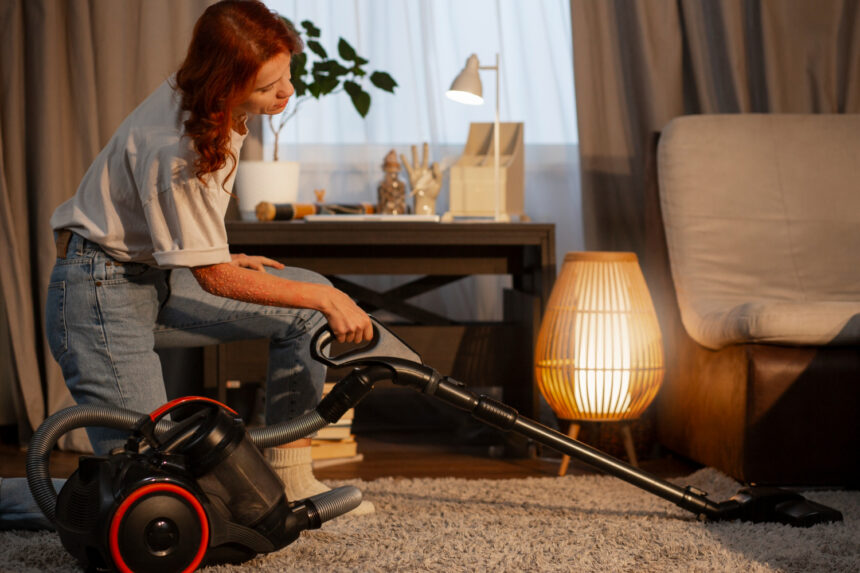Carpet cleaning is essential for maintaining a fresh and healthy home environment. Regular cleaning not only removes dirt and stains but also extends the life of carpets, making them look new for longer. Many people may wonder about the best methods to clean their carpets, whether to tackle it themselves or hire professionals.
For those considering DIY options, understanding the fundamentals of carpet cleaning is crucial. Utilizing the right techniques and pre-cleaning strategies can lead to better results and a more efficient process. However, it may be beneficial to explore professional services that can provide a deeper clean and save time.
There are many options available for carpet cleaning, ranging from steam cleaning to dry cleaning. Each method has its own advantages and is suited for different types of carpets and stains. With the right knowledge, anyone can achieve cleaner carpets and a healthier home.
Key Takeaways
- Regular carpet cleaning improves appearance and longevity.
- DIY methods require understanding of proper techniques.
- Professional services can offer a more thorough clean.
Fundamentals of Carpet Cleaning
Carpet cleaning is essential for maintaining a clean and healthy home environment. Understanding the types of carpets, common cleaning methods, and selecting the right supplies is key to effective cleaning.
Types of Carpets and Their Specific Needs
Different carpets require different cleaning approaches. For example, wool carpets are soft and durable but can be sensitive to high heat and harsh chemicals. They benefit from gentle cleaning methods and pH-neutral products.
Synthetic carpets, like nylon and polyester, are more resistant to stains and easier to clean. They can handle stronger cleaning solutions. It’s important to identify the carpet type before cleaning to avoid damage.
Shag and Berber carpets have unique textures that can trap dirt and debris. They often need vacuuming more frequently and special cleaning to lift the fibers without causing matting.
Common Carpet Cleaning Methods
There are several effective carpet cleaning methods:
- Vacuuming: This is the most basic yet crucial method. Regular vacuuming helps in removing surface dirt, especially in high-traffic areas. It is best to vacuum at least once a week.
- Spot Cleaning: Immediate attention to stains using a clean cloth or paper towel can prevent long-term damage. Blot the stain and use a suitable cleaner on the area.
- Steam Cleaning: This method uses hot water and steam to lift dirt deep within the carpet fibers. It’s often done with a machine that can extract moisture afterward.
- Dry Cleaning: This involves using special powders or solvents that attract dirt. The powder is worked into the carpet and then vacuumed out.
Choosing the Right Cleaning Supplies
Selecting the right cleaning supplies is crucial for effective carpet care.
- Vacuum cleaner: A vacuum with adjustable height and strong suction is ideal for all carpet types.
- Cleaning solutions: It’s important to choose CRI Certified products that have been tested for safety. For spot cleaning, consider homemade solutions made with dish soap and vinegar.
- Tools: Use soft brushes, microfiber cloths, and blotting materials to avoid damaging the carpet fibers.
- Machine: If using a carpet cleaner, ensure it’s suitable for the carpet type. Always follow the manufacturer’s guidelines for cleaning and maintenance.
Pre-Cleaning Strategies
Proper preparation before cleaning carpets can lead to better results and a faster process. Various strategies ensure that the carpet cleaning is thorough and effective.
Assessment of Carpet Condition
Before starting the cleaning process, it’s important to assess the carpet’s condition thoroughly. This includes checking for specific stains, odors, or areas with heavy traffic.
- Look for Stains: Identify any spots needing special care, such as pet stains or red wine spills.
- Inspect for Damage: Check for fraying, tears, or loose seams that could worsen during cleaning.
- Type of Carpet: Consider the material and pile type. Different carpets require different cleaning methods.
This assessment can help in deciding on the appropriate cleaning products and techniques that will be most effective without causing damage.
Removal of Furniture and Preparations
Clearing the area is essential to ensure a thorough cleaning. Start by moving smaller items off the carpet.
- Clear Surfaces: Remove small furniture, decorations, and personal items.
- Protect Larger Items: For larger furniture, place plastic protectors under legs to avoid water damage during cleaning.
Additionally, it’s helpful to vacuum the carpet before cleaning. This action removes loose dirt and dust, making the cleaning process more efficient.
Spot and Stain Pre-Treatment
Pre-treating stains can significantly improve cleaning results. This step breaks down stubborn spots and reduces cleaning time.
- Identify Problem Areas: Focus on stains that need attention. Use a high-quality pre-treatment product formulated for specific types of stains.
- Apply Strategically: Spray or dab the solution directly on the stains, but avoid soaking the carpet. Allow it to sit for a few minutes.
- Blot, Don’t Rub: Use a clean cloth to blot the area, lifting the stain without damaging the fibers.
Pre-treating with the right approach enhances the overall effectiveness of the carpet cleaning process.
Carpet Cleaning Techniques
Various carpet cleaning techniques cater to different needs and types of carpets. Each method has its benefits and suitability depending on the extent of cleaning required and the type of stain or dirt present.
Steam Cleaning Process
Steam cleaning, often called hot water extraction, uses hot water to deeply clean carpets. A machine heats water and mixes it with cleaning solution. The heated mixture is sprayed onto the carpet fibers.
As the water penetrates the fibers, dirt and stains dissolve. The machine then aspirates or sucks back the dirty water, leaving the carpet cleaner.
This method is effective for removing allergens, dust, and pet dander. It also helps in sanitizing the carpet, making it a great option for homes with kids or pets.
Regular steam cleaning can extend the life of a carpet. It is recommended every 12 to 18 months for the best results.
Dry Cleaning Options
Dry cleaning involves using minimal water and specialized cleaning compounds. This method is ideal for carpets that cannot withstand excess moisture.
Firstly, a dry cleaning powder or foam is applied to the carpet. The powder absorbs soil and stains and is then vacuumed away.
This technique is less time-consuming, as it doesn’t require long drying periods. Many dry cleaning products also contain solvents that help break down tough stains.
This process is suitable for routine maintenance, as it can refresh carpets without deep cleaning. It can also be effective in commercial settings where quick turnaround times are crucial.
Shampooing Technique
Shampooing is a traditional and straightforward method for carpet cleaning services. In this process, a specialized cleaning solution is applied using a carpet shampooer or machine.
The machine agitates the carpet fibers, allowing the shampoo to penetrate and lift dirt and stains. Afterward, a vacuum is used to extract the dirty suds from the carpet.
This method works well for overall surface dirt and minor stains. It is important to allow the carpet to dry completely to prevent mildew or mold growth.
Regular shampooing, approximately every six months, can improve the appearance of carpets. This technique is especially good for high-traffic areas that accumulate dirt quickly.
Encapsulation Method
The encapsulation method uses synthetic detergents that crystallize dirt into powder. This technique is water-efficient and environmentally friendly.
During the process, the carpet is pre-treated with an encapsulation agent. A machine with rotating brushes then works the solution into the carpet fibers.
After a brief period, the soil becomes encapsulated in a crystal form. A vacuum is used to remove this powder along with the trapped dirt.
Encapsulation is fast-drying, allowing carpets to be used shortly after cleaning. It is suitable for both light cleaning and maintenance, making it a practical choice for busy households.
Aftercare and Maintenance
Aftercare and maintenance are crucial for keeping carpets in great condition. Proper attention can extend the life of carpets and maintain their appearance. This section outlines effective daily care practices, how often to perform deep cleaning, and ways to address odors.
Daily Maintenance Tips
Daily maintenance is essential for carpet longevity. Regular vacuuming is key. It removes dirt and allergens that can settle into carpet fibers. Aim to vacuum at least once a week, more often in high-traffic areas.
Tips for effective vacuuming:
- Use the right vacuum: Ensure it has good suction and is suitable for your carpet type.
- Make slow passes: Take your time to ensure all dirt is lifted out.
Additionally, placing mats at entryways can help trap dirt before it enters the home. Encouraging family and guests to remove shoes before stepping on carpets also reduces wear and tear.
Deep Cleaning Frequency
Deep cleaning should be done every 6 to 12 months, depending on foot traffic and usage. This process helps remove stains and deep-seated dirt.
Signs that a deep clean is needed:
- Visible stains or discoloration.
- A persistent odor that doesn’t go away with regular cleaning.
Using professional cleaning services may provide thorough cleaning without damaging the carpet. Homeowners can also use a carpet cleaner, following the manufacturer’s instructions carefully. Regular deep cleaning helps maintain a fresh and clean environment.
Addressing Odors and Maintaining Freshness
Odors in carpets can stem from various sources, such as spills, pets, or mildew. To keep carpets smelling fresh, act quickly when spills occur. Blot stains with a clean cloth instead of rubbing, which can spread the stain.
Tips for maintaining freshness:
- Baking soda: Sprinkle on carpets and leave for a few hours before vacuuming to absorb odors.
- Regular air out: Open windows to let fresh air circulate, especially after cleaning.
Using a carpet deodorizer made for carpets can also help keep odors at bay. Consistent attention to these details will ensure carpets remain inviting and pleasant throughout the year.
Professional Carpet Cleaning Services
Professional carpet cleaning services offer expertise and efficiency in maintaining carpets. These services can improve the look and lifespan of carpets while ensuring a healthier home environment.
Benefits of Hiring Professionals
Hiring professional carpet cleaners brings many advantages. First, they use specialized equipment and tools that are more effective than household methods. These professionals can remove tough stains, allergens, and dirt effectively.
In addition, they understand different carpet types and the best methods to clean them without causing damage. Many companies also use eco-friendly products that are safe for children and pets.
Moreover, service providers often offer additional treatments, like stain protection and odor removal. By opting for professional cleaning, the time spent on cleaning is reduced, allowing individuals to focus on other tasks.
How to Choose a Carpet Cleaning Service
When selecting a carpet cleaning service, consider several important factors. Start with checking customer reviews and ratings. Websites or social media can provide insights into the quality of service provided.
Next, inquire about the cleaning methods used. Some companies may offer steam cleaning, while others specialize in dry cleaning techniques. It’s crucial to select a service that matches specific cleaning needs.
Additionally, check for certifications and insurance. A certified cleaner will have the necessary training to perform the job safely. Lastly, ask for a detailed estimate, comparing the cost and services included to find the best value.
Understanding Pricing and Services Offered
Pricing for carpet cleaning can vary widely based on several factors. Common pricing structures include charges per room, square foot, or even by the type of carpet.
Most services typically offer packages that can include basic cleaning, deep cleaning, and additional treatments for spots or stains. Customers should be aware of what each package includes to avoid unexpected costs.
Some companies may also provide discounts for multiple rooms or referral programs. It’s advisable to ask about ongoing promotions or special deals. Understanding these pricing details helps ensure that customers receive the services they need within their budget.




